
Mountaineering, mountain climbing, or alpinism is a set of outdoor activities that involves ascending mountains. Mountaineering-related activities include traditional outdoor climbing, skiing, and traversing via ferratas that have become sports in their own right. Indoor climbing, sport climbing, and bouldering are also considered variants of mountaineering by some, but are part of a wide group of mountain sports.
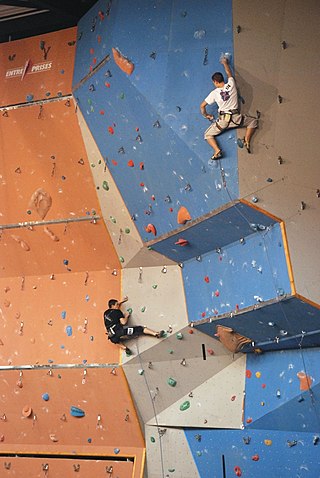
A climbing wall is an artificially constructed wall with manufactured grips for the hands and feet. Most walls are located indoors, and climbing on such walls is termed indoor climbing. Some walls are brick or wooden constructions, but on most modern walls, the material most often used is a thick multiplex board with holes drilled into it. Recently, manufactured steel and aluminum have also been used. The wall may have places to attach belay ropes, but may also be used to practice lead climbing or bouldering.

A climbing harness is a piece of equipment that allows a climber to tie in to the safety of a rope. It is used in rock and ice climbing, abseiling, and lowering; this is in contrast to other activities requiring ropes for access or safety such as industrial rope work, construction, and rescue and recovery, which use safety harnesses instead.

An ice axe is a multi-purpose hiking and climbing tool used by mountaineers in both the ascent and descent of routes that involve snow, ice, or frozen conditions. Its use depends on the terrain: in its simplest role it is used like a walking stick, with the mountaineer holding the head in the center of their uphill hand.

Glossary of climbing terms relates to rock climbing, mountaineering, and to ice climbing.

Ice climbing is a climbing discipline that involves ascending routes consisting of frozen water. To ascend, the ice climber uses specialist equipment, particularly double ice axes and rigid crampons. To protect the route, the ice climber uses steel ice screws that require skill to employ safely and rely on the ice holding firm in any fall. Ice climbing routes can vary significantly by type, and include seasonally frozen waterfalls, high permanently frozen alpine couloirs, and large hanging icicles.
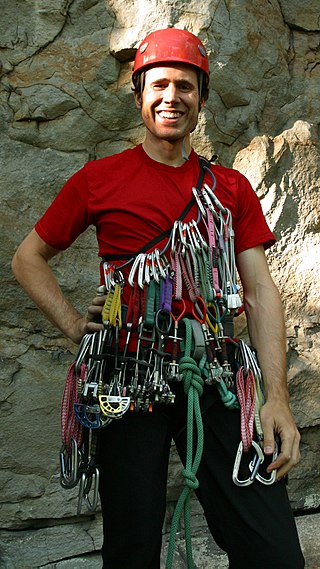
Rock-climbing equipment varies with the type of climbing undertaken. Bouldering needs the least equipment outside of shoes and chalk and optional crash pads. Sport climbing adds ropes, harnesses, belay devices, and quickdraws to clip into pre-drilled bolts. Traditional climbing adds the need for carrying a "rack" of temporary passive and active protection devices. Multi-pitch climbing adds devices to assist in ascending and descending fixed ropes. Finally, aid climbing uses unique equipment.

In climbing and mountaineering, the term belaying refers to techniques used to create friction within a climbing protection system, particularly on a climbing rope, so that a falling climber does not fall very far. A climbing partner typically applies tension at the other end of the rope whenever the climber is not moving, and removes the tension from the rope whenever the climber needs more rope to continue climbing. The belay is the place where the belayer is anchored, which is typically on the ground, or on ledge but may also be a hanging belay where the belayer themself is suspended from an anchor in the rock on a multi-pitch climb.
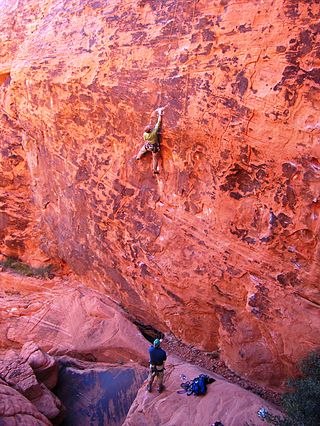
Top rope climbing is a form of rock climbing where the climber is securely attached to a climbing rope that runs through a fixed anchor at the top of the climbing route, and back down to the belayer at the base of the climb. A climber who falls will just hang from the rope at the point of the fall, and can then either resume their climb or have the belayer lower them down in a controlled manner to the base of the climb. Climbers on indoor climbing walls can use mechanical auto belay devices to top rope alone.

In rock climbing, a nut is a metal wedge threaded on a wire that climbers use for protection by wedging it into a crack in the rock. Quickdraws are clipped to the nut wire by the ascending climber and the rope threads through the quickdraw. Nuts come in a variety of sizes and styles, and several different brands are made by competing manufacturers. Most nuts are made of aluminum. Larger nuts may be threaded on Dyneema cord instead of wire, but this has become unusual.
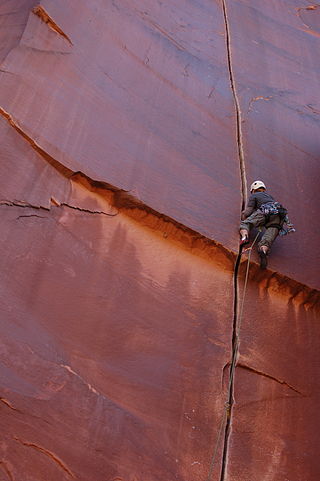
Rock climbing is a sport in which participants climb up, across, or down natural rock formations or indoor climbing walls. The goal is to reach the summit of a formation or the endpoint of a usually pre-defined route without falling. Rock climbing is a physically and mentally demanding sport, one that often tests a climber's strength, endurance, agility and balance along with mental control. Knowledge of proper climbing techniques and the use of specialized climbing equipment is crucial for the safe completion of routes.

The Munter hitch, also known as the Italian hitch, mezzo barcaiolo or the crossing hitch, is a simple adjustable knot, commonly used by climbers, cavers, and rescuers to control friction in a life-lining or belay system. To climbers, this hitch is also known as HMS, the abbreviation for the German term Halbmastwurfsicherung, meaning half clove hitch belay. This technique can be used with a special "pear-shaped" HMS locking carabiner, or any locking carabiner wide enough to take two turns of the rope.

Multi-pitch climbing is a type of climbing that typically takes place on routes that are more than a single rope length in height, and thus where the lead climber cannot complete the climb as a single pitch. Where the number of pitches exceeds 6–10, it can become big wall climbing, or where the pitches are in a mixed rock and ice mountain environment, it can become alpine climbing. Multi-pitch rock climbs can come in traditional, sport, and aid formats. Some have free soloed multi-pitch routes.
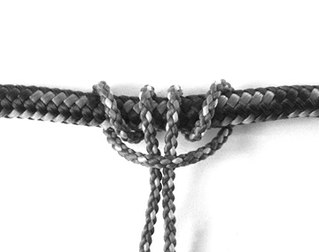
A Prusik is a friction hitch or knot used to attach a loop of cord around a rope, applied in climbing, canyoneering, mountaineering, caving, rope rescue, ziplining, and by arborists. The term Prusik is a name for both the loops of cord used to tie the hitch and the hitch itself, and the verb is "to prusik" or "prusiking". More casually, the term is used for any friction hitch or device that can grab a rope. Due to the pronunciation, the word is often misspelled Prussik, Prussick, or Prussic.
In rock climbing, an anchor can be any device or method for attaching a climber, rope, or load to a climbing surface—typically rock, ice, steep dirt, or a building—either permanently or temporarily. The intention of an anchor is case-specific but is usually for fall protection, primarily fall arrest and fall restraint. Climbing anchors are also used for hoisting, holding static loads, or redirecting a rope.

A dynamic rope is a specially constructed, somewhat elastic rope used primarily in rock climbing, ice climbing, and mountaineering. This elasticity, or stretch, is the property that makes the rope dynamic—in contrast to a static rope that has only slight elongation under load. Greater elasticity allows a dynamic rope to more slowly absorb the energy of a sudden load, such from arresting a climber's fall, by reducing the peak force on the rope and thus the probability of the rope's catastrophic failure. A kernmantle rope is the most common type of dynamic rope now used. Since 1945, nylon has, because of its superior durability and strength, replaced all natural materials in climbing rope.

An ice tool is a specialized elaboration of the modern ice axe, used in ice climbing, mostly for the more difficult configurations. Ice tools are used two to a person for the duration of a pitch, and thus in some circumstances such as top-rope-anchored climbs, a pair may be shared among two or more people, where only one of them at a time is climbing. In contrast a classical "ice axe" is used one to a person for the hours or days a party is traveling across snow or glacier. In communities where it is common to refer to an "ice tool" simply as an "ice axe", classic "ice axes" are often referred to as "traveling axes", "walking axes", or "general mountaineering axes" to distinguish them from "tools".

A belay device is a mechanical piece of climbing equipment used to control a rope during belaying. It is designed to improve belay safety for the climber by allowing the belayer to manage their duties with minimal physical effort. With the right belay device, a small, weak climber can easily arrest the fall of a much heavier partner. Belay devices act as a friction brake, so that when a climber falls with any slack in the rope, the fall is brought to a stop.

The Abalakov thread, also known as a V-thread, A-thread, or 0-thread, is an ice protection technique named after its inventor, Soviet climber Vitaly Abalakov. The Abalakov thread is a common method of protecting oneself while ice climbing because it is easy to create, does not require the sacrifice of expensive gear, and can be very safe when used properly. An Abalakov thread is often used in multi-pitch ice climbing routes. Because of its safety and convenience, the Abalakov thread is considered one of the most significant innovations in ice climbing. It significantly expanded the scope of possible routes and abseiling safety.

Saxon Switzerland is the largest and one of the best-known rock climbing regions in Germany, located in the Free State of Saxony. The region is largely coterminous with the natural region of the same name, Saxon Switzerland, but extends well beyond the territory of the National Park within it. It includes the western part of the Elbe Sandstone Mountains and is the oldest non-Alpine rock climbing region in Germany. Its history of climbing dates back to the first ascent in modern times of the Falkenstein by Bad Schandau gymnasts in 1864. Currently, there are over 1,100 peaks with more than 17,000 climbing routes in the Saxon Switzerland area.






















